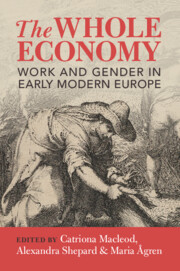1 - Households
Published online by Cambridge University Press: 09 June 2023
Summary
This chapter demonstrates the need for new and more precise concepts to make sense of early modern households. First, it questions the usefulness of the three-sector model with the argument that many households were active across sectors and their main employment can be hard to identify. Second, with the help of early modern letters, it shows that reliance on several sources of income was not necessarily a sign of vulnerability as it applied to both wealthy and less wealthy households. Third, using work activity data it indicates that the male breadwinner model does not fit with early modern realities. Married women and men were active in most types of work and their authority and responsibilities made them similar to each other and different from the unmarried. Fourth, it argues that it is misleading to conceptualize the household as a closed unit characterized by patriarchal hierarchies. Households had to be open to the surrounding society. Fifth, it demonstrates that, to take advantage of the many links to the outside world, household heads were prepared to delegate and deputize. As a result, economic agency was more dispersed in the population than is usually acknowledged.
Keywords
- Type
- Chapter
- Information
- The Whole EconomyWork and Gender in Early Modern Europe, pp. 26 - 52Publisher: Cambridge University PressPrint publication year: 2023



